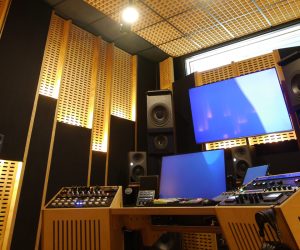
Driving a Viral Hit
OK GO have jumped off the treadmills to play a song with a car. Singer Damian Kulash talks AT through the six months it took to create a 4km-long course of found instruments, and how they recorded and mixed their latest viral hit.
It all started with four grown men running on treadmills, watched over 13 million times. Trained dogs on spinning chairs, always a classic meme, netted another 13 million views. Then there was the Rube Goldberg machine designed with the help of NASA scientists that pulled in a whopping 35 million views. Even if the OK GO name isn’t familiar to you, you’ve still probably seen one of the band’s viral videos.
Their latest video stunt put the four guys in a Chevy Sonic with robotic appendages, and sent them careering down the guts of a 4km-long course, playing Needing/Getting, a song off their latest album, using the car as a stick/beater/plectrum/fist. It was one of a handful of videos bankrolled by Chevy to promote a new car.
It’s been watched around 20 million times.
THE PITCH
A while ago, as is the norm for OK GO, they were asked to pitch video ideas. This time, using cars. A while later, the ad agency where the band’s co-conspirator/director Brian Perkins works, happened upon Chevy’s advertising campaign. He pitched the idea, and they loved it. “It’s pretty thrilling to be able to have that type of network,” said singer Damian Kulash. “Anyone can have an insane idea but actually getting the meal ticket to do it is the hard part.”
The shoot went for four days, but pre-production went for a staggering six months — four intensive, with two months of prep. The team included an MIT media lab expert in experimental instrument design, a member of Glank, a band that makes music from found and junkyard instruments, Bo Sundberg, who was the sound designer that helped rig up the recording, and about 20 people to build the contraption.
The song Needing/Getting was chosen because it had a linear structure, without complicated chords, and was rhythmic. As Kulash pointed out, “the sounds we could make with the car were heavily skewed towards rhythmic sounds. Because all that energy of the car is a lot harder to translate into a long sustained note than it is to just bang.”
WIDE TRACK
With nine Go Pro cameras recording audio, three shotguns on top of the car, as well as three more external mics, and the headsets each member sang into, the final mix was track heavy.
Damian Kulash: “Each pass we got about 20 takes of audio. Even the final mix, which was heavily culled, was 180 tracks. We were able to chop between parts that worked the best. If the rhythm on one take was really good but we missed a couple of notes, then we could just cut in a couple of notes from a different take.”
Mark Davie: Would the set up change between takes?
DK: The three roof-mounted shotguns moved around from take to take. Each section of the track was done separately, so the stereo pair would move to get the best picture of that piece of track. The only place where there was any individual miking was on the guitar amps. The guitars were all sub-mixed into little DOD pedals that have four inputs and one out.
MD: Did you have any issues with some instruments being too soft while others were ridiculously loud?
DK: The PVC basses were the most frustrating. In the chorus tunnel the paddle on the driver’s side smacks along PVC tubes. They give a great sound, but it’s not super loud. So filtering down to get the fundamental, and make it loud, was a bit of a sound chore. And the string basses were quieter than we wanted them to be — the low end stuff was the hardest to get to sound right.
MD: Was there a lot of filtering in the mix to sculpt that raw sound?
DK: It’s definitely the prettiest picture you could hear. There was a lot of filtering, a lot of compression, and a lot of gating. If we needed a lot more low end, we’d just crank up the EQ. The truth is, in most places what you actually heard was much more like ‘clank, clank, bonk, bonk’ than how it sounded once we had sweetened it up. We were treating it like a live recording session of an extremely strange event. Any mixing tools we could use to make it more musical were necessary, given what a difficult set it was.
MD: What were some of the difficulties of playing the song with a car?
DK: Inside the car we’re singing along with the click. That’s actually how I kept my speed in time with the song. In every bar there’s a flag to my left shoulder. So the way I’m timing my speed is listening to the click and trying to make sure I’m hitting those downbeats side to side.
We’d get the key before we’d start and then we’d sing along with the click. The sound within the car was mostly rumble, so it’s pretty easy to filter out. Outside the car there was a lot of gravel noise and rumble. But again it’s pretty easy. From there you have 20 tracks for each pass and you just figure out which one counts the best.



BUILDING INSTRUMENTS
MD: What were some of the main physics basics that affected the construction of the instruments?
DK: What we discovered, and should have known going into it, was that low notes are a lot harder to make with kinetic energy than high ones. The studio version of the song is almost all bass with one guitar line over the choruses. We didn’t have a lot of options for basses. What can you bang that makes a low note?
Bells for instance, are like the third octave of a piano. They get to be all overtone and no fundamental. Think about church bells, even the lowest ones become indiscriminate notes — they’re all overtones. We found it very hard. We did a lot of experimentation with propane and other cylindrical tanks. You could tune them decently but it was really hard to get more than one note out of a given bass material.
You can take a propane tank and cut it down to get a D pretty nicely, but to get an E is almost impossible. You could barely get more than a third or a fourth out of a single instrument.
The hand-made, stand-up basses with the piano strings strung across it are basically the same bass instruments you hear in a jazz band. I had no idea how much the bridge placement matters. If you move the bridge on these things two inches in either direction it completely changes the volume, and the note, because you not only change the length of the string, but the resonant sweet spot, which was ridiculously small. The PVC basses were a really nice discovery, because you can just keep going lower and lower with those, though you start to lose a bit of volume.
The high notes were a lot easier and we could get square steel bars for triangles. Our super nerd scientist said they wouldn’t work, but they sounded amazing. With aluminium in general, you get all fundamental and no overtones, which is super useful.
Oh, and the ridge synthesis was really cool. At the same time as we played the tubas, we had a fishing rod that comes out of the driver’s side door and scrapes a piece of plastic and makes a high note. Getting that to work was a real challenge. In theory, if you make a click go fast enough it’s going to turn into a note. So we should be able to make a certain number of clicks per second turn into the fundamental of D — the root of the song. We tried wrapping wire around boards, rubber mats, all sorts of different things. In the end we just had to manufacture it, because there was no pre-made product that could make that sound. It’s plastic with ridges in it with exactly the right spacing for the pitch at 27mph. We discovered that if the activator making the click can regulate too much, each click overlaps with the click before it so that you don’t get ‘tick, tick, tick’, you’re instead hearing the decay of the one before it, producing a cloud of sound instead of a note. Whereas if it’s all attack and no decay, you can get them close enough together to approximate the wave, and you get the note you’re looking for.
MD: What are some things that didn’t work?
DK: We wanted to create a giant thumb piano and realised with the hardware that thumb pianos only work in small scale. As you get larger the notes don’t get lower, they just stop being notes.
We thought we could put tubes on top of the car and catch the air to make a whistle. Same as when you spin a tube like a helicopter blade above your head. But that only works if it has ridges in it. What’s happening is the centrifugal force of the spinning is pulling air through it and the turbulence over those ridges is what causes those notes. We spent a lot of time on the highway with different lengths of that tubing and we found that you could definitely predict that at a certain speed and a certain length we could make a certain note. However it’s really finicky — a little gust of wind and it would stop. And you would also get overtones. A section of tubing that was a foot and a half long, you’d be getting the second partial, whereas one that was three feet long would be getting a fifth partial.
Once we were at a given speed we couldn’t make an instrument that had more than two or three notes in it. If the lowest tube was playing an A and I wanted to make the next one a B, by the time you cut down the tube to a B that tube would now play the lower fundamental in the harmonic overtone. So you’re not getting a B, just some random other note that’s lower than the A. There was no way to get a predictable full scale. And we needed four or five notes for the part that we wanted.
VIRAL TIPS
MD: What mixing tips can you give that are specific to YouTube video as opposed to a record?
DK: When someone’s watching your video on YouTube you can assume they’re likely to be watching it with laptop speakers, so fidelity is not nearly as important as energy — especially with low end. You want to make sure that you keep the high end of those instruments in, because those little speakers are definitely not going to be able to produce the low end.
If you want something to spread around the internet, the first and most obvious rule — one that people overlook all the time — is to make something that provides a feeling that people want to share. For example, what works on nightly news tends to be fear, anxiety and what’s wrong in the world. But when you’re sitting at your desk and see that, you’re not likely to think, “Oh, I feel so great, I want my girlfriend to feel like this.”
















RESPONSES